GET REALLY FASTLook at the front leg. This is why we parallel squat. Now, look at the back leg. This is why we power clean and/or power snatch.By Dr.Greg Shepard Published: Winter 2003 What are the real keys to improving speed? What can you do to develop speed in the best and fastest way possible? BFS has the answers to these questions. If your team follows our BFS guidelines for speed, I guarantee that you will always be the fastest team in your conference and always among the fastest team in your state for high school. I’ll make the same kind of guarantee at the college level. There are three basic rules about speed that must be clearly understood. Most people do not clearly understand these rules or components. Therefore, if you accept and understand what I am about to tell you, you will be on your way to achieving great team - or individual speed. RULE #1: You can improve speed significantly. It is amazing to me, but there are still individuals who believe you are born with your speed and there is nothing you can do to get faster. That is so ridiculous that it is tragic. There are many things you can do to improve speed. It is easy to go from a 5.9 forty to a 5.2 or from 5.6 to a 5.0 forty. It is easy to improve from a 5.2 forty to a 4.8 or from a 5.0 to a 4.6 forty. You can even go from a 4.8 to a 4.5 in a year or from a 4.6 to a 4.4 or 4.3 in the same time period. I can make these statements because we have been able to make these kinds of improvements with literally thousands of athletes. RULE #2: You must use a variety of speed improvement components. Many people concentrate on only one component of speed improvement or a gimmick to improve speed. This is not the answer. For example, an athlete might wear a special shoe or use a parachute or work on stride length. Many athletes will work only on technique drills. I am not saying it is bad to do this, but if you want to get an edge on everyone else, you will need to use all of the BFS components for speed improvement. We have ten such components. RULE #3: Everything you do in your strength and conditioning program should be related to speed improvement. Since very few people in strength and conditioning programs are even aware of this rule, you will get an edge on your opponents when you implement, coordinate and have a speed relationship among all phases of the BFS total strength and conditioning program. For example, why do you stretch? Others say that they stretch to prevent injuries, while we at BFS stretch to improve speed and jumping power. Therefore, when we stretch, we make sure our body, toes and legs complement and reinforce correct sprinting technique. We know that very few programs include this perspective. This is why you will get the edge in speed that you desire. The following will give you a detailed understanding of the first of these ten speed-components of Bigger Faster Stronger and how they relate to speed improvement. This will be the first in a series of articles, to be continued in upcoming issues. SPEED COMPONENT #1: STRENGTH There are only three strength lifts needed for improving speed. First, the parallel squat. On a scale of 1 to 10, the parallel squat gets an 11 in importance in getting really fast. Second, the power clean or power snatch gets a 10 on the speed improvement scale. The straight leg deadlift comes in third place. I give this exercise an 8. All other lifts would score less than an 8. THE PARALLEL SQUAT: Look at the sprinter page 44. Focus on the forward leg and the angle of the upper leg as compared to the lower leg. You will see that it is a 90-degree angle. Some coaches argue that you do not need to go parallel when doing squats because they compare the upper leg with the ground. Big mistake. Parallel squats are the most important lift you can do to improve speed. Now look at Figure #1 of the De La Salle running back. Besides having impressively powerful thighs, look at both legs and their angles. Again, the front leg is at a 90-degree angle just as in a parallel squat. The back leg position is that of a power clean or our hip flexor stretch. Next, look at Figure #2 of Derek Jeter of the New York Yankees. Parallel Squat! Figure #3 shows a front angle of 100-meter world record holder Tim Montgomery. Again, the front leg shows a parallel squat angle, while the completely extended back leg is the same as in our power clean technique. Women athletes gain the same benefit and can also get really fast with the BFS program. Angela Williams, Figure #4, is considered to have the fastest start in the world. Look at the lead leg. What angle is the upper leg in as compared to the lower leg? Parallel squat. The back leg is exploding to a completely extended position that looks exactly like our BFS power clean position when completely extended. You can work with a 5.9 forty athlete all day, every day, on technique, drills and stride length fundamentals and not make much improvement. Weakness is the fundamental issue. Parallel squats provide the basis for speed improvement. I can take any athlete and make him/her significantly faster by doing perfect parallel squats. The athlete may still have lousy form but will run significantly faster with a big improvement in parallel squat strength. Parallel squats are the single most important thing you can do to improve speed. Early in my career, I was in the Los Angeles area training with track athletes (throwers) during the summers. I was amazed at their size and speed. There were about 30 throwers who weighed an average of 270 pounds running between 4.6 and 4.8. Pro football players were not even close to that. I wanted my high school football players back at Sehome High School in the state of Washington to be like those throwers. So when I returned, we parallel squatted like those throwers and practiced sprinting. We timed our players twice per month. We did not do a very good job with power cleans but we were superior at the parallel squat. See Figure #5 and you will see what I mean. Little Greg Frere at a bodyweight of 155 parallel squatted 355 pounds and ran a 4.6 forty. Look at his depth and form: eyes on target and being tall with the chest spread. This photo was part of a story that featured my program at Sehome in the old Strength & Health magazine. We did a good job at only two of the ten components we have today, but we did those very well. It took only a year to get phenomenal results. I had 50 players run between 4.5 and 5.0 in the forty. That was 1970. Can anyone match that today? Sehome had an enrollment of 1,400 in grades 9-12. We played mostly larger schools and ended up playing Snohomish High School in a mythical state championship. They had minus 77 yards. My next move took me to Brigham Young University, where I worked with football players and the power lifting team. Paul Howard, a lineman, gained 45 pounds in one year, reaching 275, and improved his forty from 5.2 to 4.8. He played ten years for the Denver Broncos. Paul Devine was a running back who was also on my power lifting team (see Figure #6). He helped us win the1973 national collegiate power lifting championship. Paul graduated and raised his family in southern California. His son Kevin was taught how to parallel squat and train (see Figure #7 and #8). Kevin ran a 4.2 forty at the combine and played in the NFL for several years. I was so impressed with Kevin that we did a football speed video featuring Kevin’s ideas on speed improvement. I once had a 5’9” 250-pound sophomore football player in 1977 named Charles who ran a 6.9 forty. “Charles,” I told him, “you may have just set a record for the slowest time in history. As I see it, you’ve got two choices. Either eat lettuce for every meal or squat like crazy.” Well, Charles didn’t like lettuce. By the end of his senior year, Charles was 5’11” and weighed 300 pounds. What do you think? Was he slower after all those squats and with that extra 50 pounds? Charles parallel squatted 745 pounds in a national competition and briefly held the teenage national record |
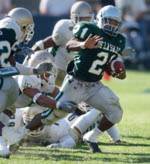 |
|
Figure #1 De La Salles High School, national football champions, does two squat workouts all-year round: One parallel squat workout and one front squat workout. They even do five reps on the parallel squat, with no weight, as part of their pre-game warm-ups. Shown is De La Salle running-back, Maurice Drew. Maurice is currently at UCLA. |
 |
|
Figure #2 New York Yankee, Derek Jeter. Notice the upper leg position - just like a squat |
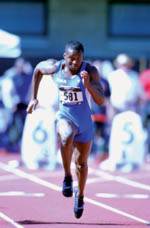 |
|
Figure # 3 Worlds fastest man Tim Montgomery. Again the front leg shows a parallel squat |
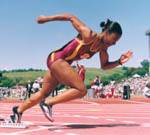 |
|
Figure #4 Angela Williams World’s fastest start |
 |
|
Figure # 5 Sehome High athlete Greg Frere back in the early 70’s |
 |
|
Figure # 6 Paul Devine with Greg Shepard spotting in 1973 |
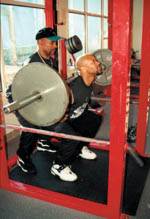 |
|
Figures #7 & 8 In 1998 Kevin Devine was the NFL’s fastest man |
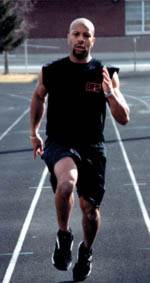 |
|
Figures #7 & 8 In 1998 Kevin Devine was the NFL’s fastest man |
 |
|
Figure #9 Charles who was 5’11 300 lbs. added 50 lbs to his squat and cut his forty from 6.9 to 5.1 and could grab the rim with both hands. |
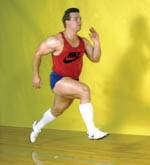 |
|
Figures #10-11 At a bodyweight of 270 lbs., Stefan Fernholm ran a legitimate 4.23 forty. He also had a parallel squat of 800 lbs. |
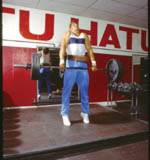 |
|
Figures #10-11 At a bodyweight of 270 lbs., Stefan Fernholm ran a legitimate 4.23 forty. He also had a parallel squat of 800 lbs. |
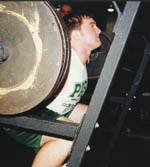 |
|
Figure #12 Tom Busch never missed a squat workout in four years. He ran a 4.47 forty. |
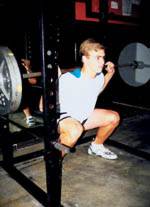 |
|
Figure #13 Conrad Ivie lowered his forty from 5.7 to 4.4 while adding 225 lbs to his squat |
 |
|
Figure #14 John Rowbotham shows a perfect parallel squat--the key to speed improvement |